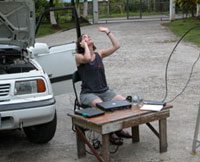February 12, 2005
Bananas and satellite phones. Monday, February 12th 2005
So here we are, waiting for the Ranger in Golfito. And waiting keeps us busy. There are arrangements with the marina to be made, communications technology for the boat to be tested, press releases to be sent out. Xavier is on the phone non-stop; I’m trying to learn as much as I can about Golfito, Cocos Island and the water in between before we abandon land and internet connection both.

Golfito (“little gulf”) is a very small town on the Pacific coast of Costa Rica, just north of the Panamanian border, set on a “sub-gulf” that emerges from the larger Golfo Dulce (“sweet gulf”) like a droplet of water from a larger drop. It was born as a banana town: from 1938-1985 Golfito was the southern Costa Rica headquarters of the United Fruit Company — the much-vilified banana empire notorious for its involvement in the 1954 U.S.-sponsored coup in Guatemala, for widespread repression of workers, and for having economically colonized much of Central America.
Golfito boomed with the banana trade. Trains carried supplies in and bananas out. The town grew along the track and is still one long, narrow strand, nearly all the buildings set along one road. In the old days a train ran here, slowly; people traveled from one end of town to the other by grabbing hold as it passed. The Company — and people here still refer to it as “la Compañia” — built a hospital, schools, a pier, and populated “el pueblo civil” with worker houses.
Then the Company left. Rising tariffs in Costa Rica and worker unrest in Golfito made the operation more trouble that it was worth in profits. Golfito was overtaken and overwhelmed by unemployment and other attendant plagues — prostitution, drug addiction, poverty. In an attempt to revive the town, the Costa Rican government recently built an enormous duty-free shopping mall here — el deposito — to attract domestic tourism. Visitors are required to spend the night. To some degree it has worked; the thing is a concrete-walled, barb-wire fenced monstrosity, but on weekends the many little hotels around town are full.
There are other reasons that things are looking up for Golfito. It is a sportfishing destination of growing popularity. There are two or three ritzy marinas on the waterfront, a handful of luxury yachts resting in the bay, and on any given evening small groups of wealthy foreign expats sipping cocktails in one of the fancy marina bars. Come day they go fishing for sailfish, marlin, and other big beauties — for $300-700 you can arrange a day-long trip.
Equally if not more encouraging, the Central American ocean conservation group MarViva has its operations base here. MarViva was created (Xavier Pastor, Carlos Perez, Maribel Lopez and Eduardo de Ana (Guayo) — now with Oceana — led the effort!) in 2002 to enforce protection of the Eastern Pacific Marine Conservation Corridor, which includes the waters around a string of five islands off the Pacific coast of Central America. A few hundred miles directly out to sea from here is Cocos Island, the marine pride of Costa Rica, one of the richest biodiversity hotspots on earth, and the next destination of the Oceana Ranger. More on Cocos in the next update.
With tourist arrivals and awareness of Golfito’s unique ecological bounty both rising, it seems likely that the town will not remain remote and unknown for long. There are rumors of new airport construction and the installation of a mega-marina. The difficult thing will be for the town to grow and thrive without sacrificing the abundance and quality of the marine life that makes it so special. In the meantime, Golfito is a strange and beautiful place — a bundle of tin-roofed houses by the bay, backed by jungle, fifty foot yachts moored next to man-powered canoes.
As regards the Ranger expedition, preparations for the boat are underway. We are lucky to have secured some incredible technology, including a satellite system that will hopefully let me transmit these updates at sea, and I spent a long afternoon yesterday trying to get the thing to work — which, thanks to very patient support from Oceana’s own IT whiz, Beth White, and an obliging gentleman at the satellite phone store, we did. So presuming we can replicate the conditions of the MarViva parking lot aboard a moving vessel in the middle of the ocean, all will be well.


